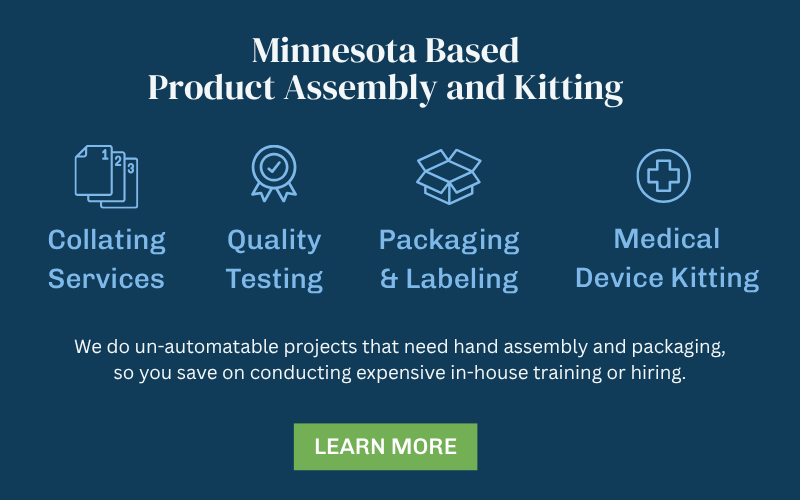Manufacturing Labor Shortage Trends in Minnesota and Wisconsin
If you run a mid-sized manufacturing business in Minnesota or Wisconsin, you’re probably feeling the pressure of the ongoing labor shortage.
Even though more people have entered the workforce post-pandemic, the number of open manufacturing jobs still far exceeds the number of available workers. In Wisconsin, there have been about 93,000 more job openings each month than unemployed people since 2021. In Minnesota, by the end of 2024, there were only about 0.6 job seekers per job opening. That means for every 10 jobs, only 6 workers are available.
When critical roles stay unfilled, it’s not just a hiring headache, it’s a threat to your bottom line. Missed deadlines, quality issues, and overworked teams all chip away at profitability, especially when your operation is already running lean.

This isn’t just a short-term problem. Minnesota’s labor market experts say we could be dealing with a tight labor market for the next 10 to 15 years. Why? The population is aging, fewer young people are entering trades, and the birth rate is lower. Even with more immigrants and workers moving in from other states, it’s not enough to fill the gap.
Why Labor Shortages Hit Manufacturing Hard
Manufacturing jobs require specific skills which is part of the problem. Welders, machinists, and technicians are in short supply. Retirements are draining experienced talent, and younger workers aren’t entering the trades fast enough. Even when you hire, the people applying often lack the skills you need.
That talent gap slows down production and disrupts workflows, forcing your team to do more with less at a higher cost. You’re stuck dealing with delayed shipments, strained vendor relationships, and elevated risk across your operation.
A recent Minneapolis Fed study showed that nearly 60% of Minnesota’s labor force growth is coming from foreign-born workers, yet the state still has hundreds of thousands of open jobs. Angelina Nguyễn, Director of Labor Market Information at Minnesota Department of Employment and Economic Development (DEED), said, “We’re still in a tight, tight labor market and I would expect that to be the case for the next 10, 15 years.”

How Reshoring Drives Manufacturing Labor Demand
The push to bring production back to the U.S. is great for long-term supply chain resilience. But it’s increasing demand for local labor. In just the first half of 2023, over 182,000 manufacturing jobs were announced nationwide due to reshoring or foreign investment. A large chunk of those are landing right here in the Midwest.
That puts you in direct competition with larger companies that can offer higher wages and signing bonuses. If you can’t match those offers, you risk losing skilled workers, delaying output, or stretching your current team to unsustainable limits. All of this erodes margins and operational efficiency.

4 Ways Labor Shortages Threaten Your Bottom Line
Your production schedule isn’t the only thing at risk: it’s your profit margin, customer satisfaction, and team morale too. If your company earns between $25 million and $160 million a year, the labor shortage is not only a staffing issue, but a business risk. Without the budget or flexibility of a Fortune 500, you’re likely already seeing the impact:
1. Slower Output, Lost Revenue
When your lines are understaffed, you can’t run at full capacity. Backlogs grow, deadlines slip, and you may even have to turn away business you know you could fulfill with the right people in place.
2. Product Quality Takes a Hit
With fewer experienced hands on deck, mistakes become more common. Defects and rework cost you money and can damage your reputation. Maintaining high standards with a lean team takes tight processes and better tracking.
3. Fulfillment Bottlenecks
Even when you meet production deadlines, understaffed warehouses create new problems. Orders sit waiting for packaging. Overtime piles up. Your best workers burn out. You lose time and money.
4. One Key Employee Leaving Disrupts Everything
If one experienced technician, machine operator, or supervisor walks out, you may feel it immediately. Without enough cross-training or backup, one departure can throw your whole schedule off.

6 Solutions to Keep Your Floor Running with a Leaner Team
As a leader in operations or supply chain, you can’t out-hire your way out of this problem. But you can outsmart it. Here’s what manufacturers like you are doing to adapt:
1. Outsource Non-Core Manufacturing Tasks
You don’t have to handle everything in-house. More manufacturers are working with third-party partners to manage labor-heavy work like kitting, packaging, or labeling. That way, your team can focus on core operations without constant overtime.
Some of these partners specialize in high-mix, low-volume work and are ISO-certified, so you don’t sacrifice quality for flexibility.
2. Automate Repetitive Manufacturing Processes
Automation lets you do more with fewer people from palletizers to barcode scanners. You’ve likely already invested in some tech but now’s the time to go further.
Wisconsin’s latest manufacturing survey showed that two-thirds of companies now see automation as essential. Many are retraining current staff to manage and maintain systems instead of trying to hire new ones.
3. Expand Your Manufacturing Talent Pool
Veterans. Women. Immigrants. People with disabilities. These groups are often overlooked, but they bring loyalty, fresh perspectives, and strong skills to your floor. In Minnesota, manufacturers working with inclusive hiring programs have found high-quality employees to fill important roles in inspection, labeling, and assembly.
4. Focus on Employee Retention
Retention is everything. Improving shift flexibility, offering small stay bonuses, or creating clearer growth paths can go a long way.
Some companies are even asking semi-retired employees to stay on-call for training or special projects. It’s a great way to hold onto valuable experience without committing to a full salary.
5. Improve Processes and Build Workforce Resilience
You can’t afford to waste time or materials. Tools like Lean, SPC, and preventive maintenance help you run smoother with fewer hands.
Cross-train your team so no critical task depends on one person. And build contingency plans for when someone leaves or gets sick. That’s how you build a resilient operation, no matter your headcount.
6. Consolidate Vendors to Simplify Supply Chains
Managing too many suppliers is a hidden labor drain. Each one means more emails, invoices, follow-ups, and room for error. Consolidating vendors gives you more control and frees up time for your team.
Bundling services like warehousing, kitting, and labeling under one roof reduces complexity.
You Can’t Hire Your Way Out, But You Can Outsource It
If you’ve been waiting for the labor market to go back to “normal,” it’s time to shift gears. The manufacturers who come out ahead aren’t the ones who hire more. They’re the ones who rethink how the work gets done.
You don’t need more people, you need smarter strategies. Start with outsourcing, tech-enabled processes, and inclusive hiring.



